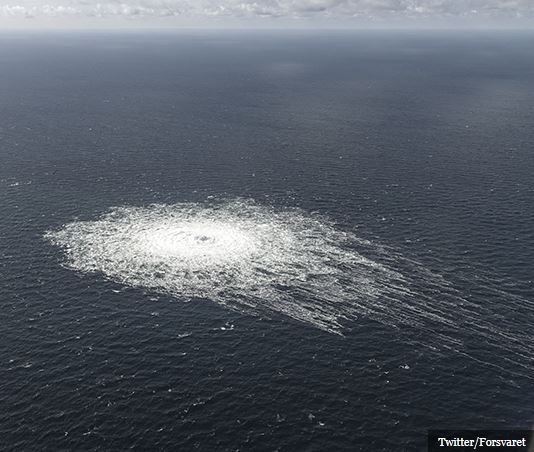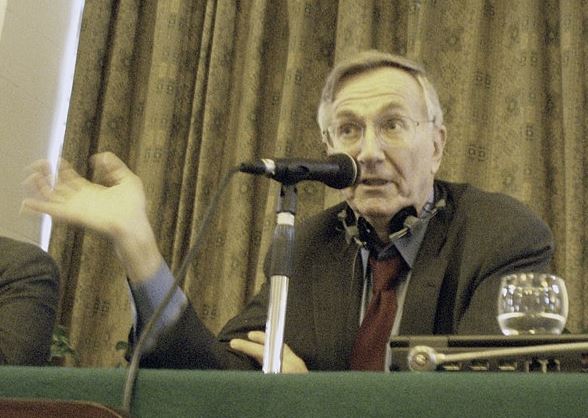
Nordstream explosion. Twitter Forsvaret, Danish Defence.
It was an act of terrorism that revolved around energy, but it’s also about free speech and the media. It’s a red-pill moment, and it was released on a blog, not in “the news”. Journalism lives — but it has moved.
Seymour Hersh is the same writer that broke the My Lai massacre and Abu Ghraib scandal. The veteran reporter won a Pulitzer prize and has an insider source and many details on his new substack blog. He claims The United States deliberately blew up the Nordstream pipes with help from Norway. The explosives were planted by divers in June under the cover of tine BALTOPS 22 NATO exercise. They were triggered by a sonar buoy dropped from a Norwegian Navy P8 surveillance plane on Sept 26th, last year.
The WhiteHouse has flatly denied it, calling it “utterly false”, but the US always had the means, the motive and the opportunity, and we all remember the day when Joe Biden made the open threat “: “If Russia invades…then there will be no longer a Nord Stream 2. … We will bring an end to it.” It turns out behind the scenes the people keeping secrets were “dismayed.”
So here we are, Energy is a national security thing, not a fairy wand to get nice weather. Gazprom’s gas and oil revenues “were estimated some years to amount to as much as 45 percent of Russia’s annual budget.” Wow.
By stopping Germany and Europe from getting access to cheap Russian gas, the US would be neutralizing Putin’s “weaponisation” of energy, though by weaponising it themselves. The US was afraid the Germans might be reluctant to send weapons to Ukraine if they also depended on Russia for gas. By helping the US, Norway would be happy to sell more gas itself. But how will cold Germans feel knowing that their electricity bills have skyrocketed? Likewise the rest of Europe. Will people in Britain connect those dots? For Europeans, their ally took away their sovereign choices.
Right now the German government could be using this news story for leverage behind the scenes. They could promise not to make a fuss if only the US does x, y and z? What’s the going price for terrorist strikes?
Will the US have to pay the carbon credits on half million tons of methane — the largest single methane leak ever? Does anybody even care enough to ask?
Will this be leading story in every news bulletin around the world, or will the headlines just read “White House forced to issue statement that the claims are utterly wrong”.
The original source is Seymour Hersch’s new blogging platform: Read it all, it’s quite the tale!
How America Took Out The Nord Stream Pipeline

Seymour Hersch, 2007 | Photo by Hossam el-Hamalawy
The New York Times called it a “mystery,” but the United States executed a covert sea operation that was kept secret—until now
Two of the pipelines, which were known collectively as Nord Stream 1, had been providing Germany and much of Western Europe with cheap Russian natural gas for more than a decade. A second pair of pipelines, called Nord Stream 2, had been built but were not yet operational. Now, with Russian troops massing on the Ukrainian border and the bloodiest war in Europe since 1945 looming, President Joseph Biden saw the pipelines as a vehicle for Vladimir Putin to weaponize natural gas for his political and territorial ambitions.
The motive:
America’s political fears were real: Putin would now have an additional and much-needed major source of income, and Germany and the rest of Western Europe would become addicted to low-cost natural gas supplied by Russia—while diminishing European reliance on America. In fact, that’s exactly what happened. Many Germans saw Nord Stream 1 as part of the deliverance of former Chancellor Willy Brandt’s famed Ostpolitik theory, which would enable postwar Germany to rehabilitate itself and other European nations destroyed in World War II by, among other initiatives, utilizing cheap Russian gas to fuel a prosperous Western European market and trading economy.
The direct route, which bypassed any need to transit Ukraine, had been a boon for the German economy, which enjoyed an abundance of cheap Russian natural gas—enough to run its factories and heat its homes while enabling German distributors to sell excess gas, at a profit, throughout Western Europe. Action that could be traced to the administration would violate US promises to minimize direct conflict with Russia. Secrecy was essential.
Norway were the obvious collaborators:
Back in Washington, planners knew they had to go to Norway. “They hated the Russians, and the Norwegian navy was full of superb sailors and divers who had generations of experience in highly profitable deep-sea oil and gas exploration,” the source said. They also could be trusted to keep the mission secret. (The Norwegians may have had other interests as well. The destruction of Nord Stream—if the Americans could pull it off—would allow Norway to sell vastly more of its own natural gas to Europe.)
With a last minute change Joe Biden called for the charges not to go off with just a two-day timer, but to sit there ready underwater on the pipe and be triggered at some later date. This caused quite a stir and much frustration. It was a much more difficult requirement:
The C4 attached to the pipelines would be triggered by a sonar buoy dropped by a plane on short notice, but the procedure involved the most advanced signal processing technology. Once in place, the delayed timing devices attached to any of the four pipelines could be accidentally triggered by the complex mix of ocean background noises throughout the heavily trafficked Baltic Sea—from near and distant ships, underwater drilling, seismic events, waves and even sea creatures. To avoid this, the sonar buoy, once in place, would emit a sequence of unique low frequency tonal sounds—much like those emitted by a flute or a piano—that would be recognized by the timing device and, after a pre-set hours of delay, trigger the explosives. (“You want a signal that is robust enough so that no other signal could accidentally send a pulse that detonated the explosives,” I was told by Dr. Theodore Postol, professor emeritus of science, technology and national security policy at MIT. Postol, who has served as the science adviser to the Pentagon’s Chief of Naval Operations, said the issue facing the group in Norway because of Biden’s delay was one of chance: “The longer the explosives are in the water the greater risk there would be of a random signal that would launch the bombs.”)
On September 26, 2022, a Norwegian Navy P8 surveillance plane made a seemingly routine flight and dropped a sonar buoy. The signal spread underwater, initially to Nord Stream 2 and then on to Nord Stream 1. A few hours later, the high-powered C4 explosives were triggered and three of the four pipelines were put out of commission. Within a few minutes, pools of methane gas that remained in the shuttered pipelines could be seen spreading on the water’s surface and the world learned that something irreversible had taken place.
How useless were the media?
FALLOUT
In the immediate aftermath of the pipeline bombing, the American media treated it like an unsolved mystery. Russia was repeatedly cited as a likely culprit, spurred on by calculated leaks from the White House—but without ever establishing a clear motive for such an act of self-sabotage, beyond simple retribution. A few months later, when it emerged that Russian authorities had been quietly getting estimates for the cost to repair the pipelines, the New York Times described the news as “complicating theories about who was behind” the attack. No major American newspaper dug into the earlier threats to the pipelines made by Biden and Undersecretary of State Nuland.
Asked why he thought the Russians failed to respond, he said cynically, “Maybe they want the capability to do the same things the U.S. did.
“It was a beautiful cover story,” he went on. “Behind it was a covert operation that placed experts in the field and equipment that operated on a covert signal.
“The only flaw was the decision to do it.”
Seymour Hersch also explains why he is writing for Substack and not the major outlets. “Here, I have the kind of freedom I’ve always fought for. “
See the videos below of all the US officials calling for action against the pipeline — looking for sanctions. Many interests in the US wanted to stop this pipeline.
In light of the Seymour Hersh bombshell on the U.S. and Norway blowing up the Nord Stream pipeline, let’s recall how U.S. officials openly incited against it for months, then blamed… Russia.https://t.co/qp1d7Jx9ry pic.twitter.com/V0Cy2JPSXI
— Dan Cohen (@dancohen3000) February 8, 2023
UPDATED: Ian Rons disagrees, and is very unimpressed with the Hersch uncorroborated story. Worth reading it. Though it smelled like a weak effort with “legal” and political points at the top. (As if any government seems bound by law these days). But one point struck — he queries whether it was necessary to hide under the BALTOPS war games, as submarines could get in there anytime. And the delayed triggering by sonar drop does sound complicated.
I also have deep reservations about the remotely-triggered detonators that were apparently designed and manufactured for this one operation on short notice, that survived over three months submerged under battery power in the cold Baltic Sea, vulnerable all the time to discovery, and which were apparently triggered by a single sonar buoy dropped from a Norwegian(!) aircraft, despite the fact that the explosions happened about 50 miles and precisely 17 hours apart. Every detail of that story raises a number of questions, but perhaps Sweden (which is carrying out the investigation) can tell us whether evidence of these sophisticated trigger devices has been found.
Nonetheless, the debunking is not a heavyweight performance. Just points worth discussing.
h/t Another Ian, Krishna Gans, Scott of the Pacific, Tony Thomas, Bill in AZ.